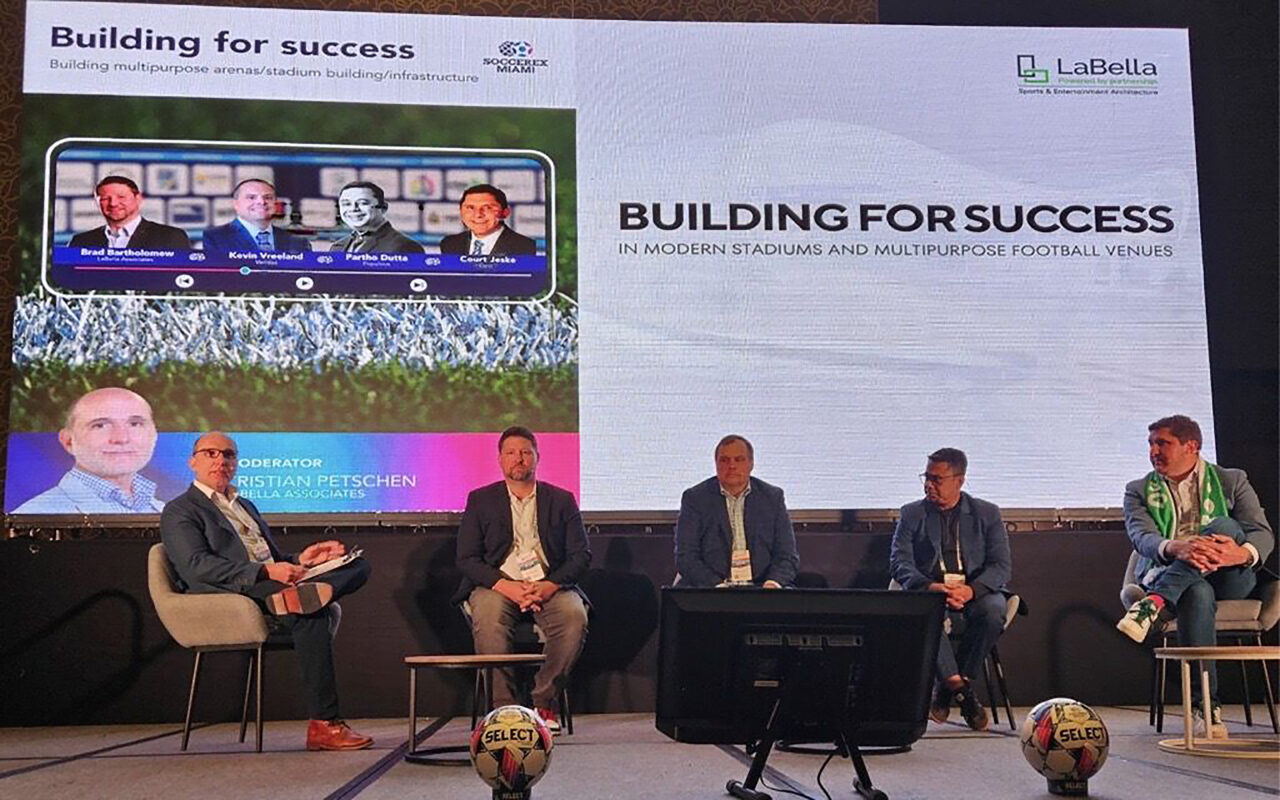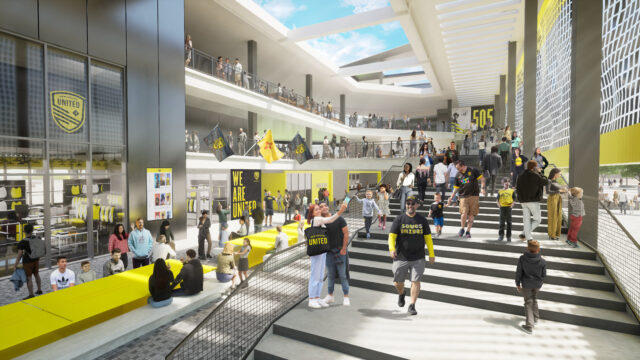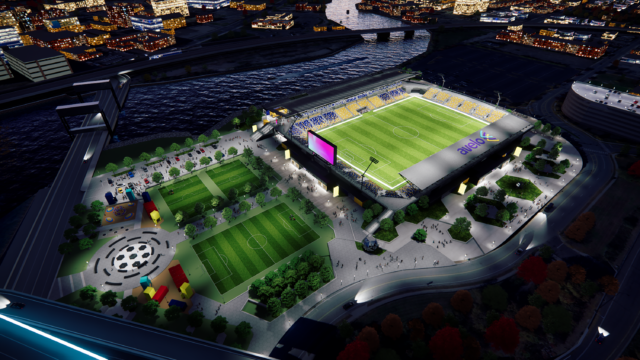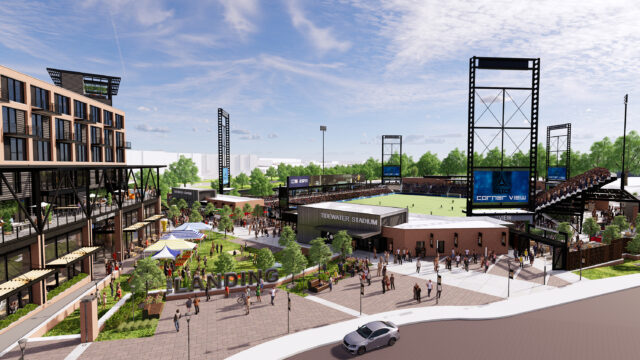Shaping the Future of Football Design: Lessons Learned at Soccerex Miami 2024

In November 2024, members of LaBella’s Sports and Entertainment Studio joined global football leaders at Soccerex Miami 2024, an annual conference dedicated to exploring the future of the sport. Held at the iconic Seminole Hard Rock Hotel and Casino, this year’s event brought together a diverse group of industry professionals for thought-provoking panels, interactive exhibits, and valuable networking opportunities.
As a global forum for advancing football, Soccerex provides a platform to discuss how the sport can foster fan and community engagement, embrace cutting-edge technologies, and drive economic growth. LaBella Associates was honored to contribute to the dialogue, hosting the panel Building for Success, which highlighted emerging trends and innovative design concepts that could redefine modern stadiums and multi-purpose football venues in the coming decade.
Throughout the event, four recurring themes stood out, each aligning with LaBella’s commitment to designing spaces where both football and communities thrive. Below, we explore the key takeaways and share how these concepts influence our work.
Sustainable Design: Shaping Resilient Venues
Sustainability has become a central focus in stadium design, with growing recognition of its role in long-term community resilience. Modern stadiums are being designed not only to serve their immediate function but also to provide lasting benefits to the environment and surrounding community. At this year’s Soccerex conference, multiple sessions emphasized the importance of integrating sustainability into every aspect of design to ensure these venues remain valuable assets for years to come.
A prime example of this shift is the Climate Pledge Arena in Seattle, Washington, the world’s first net-zero stadium. This all-electric venue features 100% renewable energy, solar panels on the roof and parking garage, and a waste diversion system that recycles or composts over 90% of its waste. Additionally, materials from the original Washington State Coliseum building were repurposed during construction.
Furthermore, as highlighted during LaBella’s panel, today’s stadiums are not only designed to meet environmental standards but are increasingly built to serve as community resources during crises, such as disaster relief centers. This shift reflects a broader change in the industry, with the focus moving beyond simply meeting basic decarbonization goals, like LEED certification, to prioritizing climate resilience.
Digital Technology Integration: Revolutionizing the Fan Experience
While sustainable design is transforming the physical structure of stadiums, technological innovations are redefining how fans interact with teams and venues. For example, the session Football, Connected described how these technologies strengthen connections with fans and help venues adapt to evolving audience expectations. Beyond streamlining operations, integrating advanced technology into stadiums creates immersive, data-driven experiences that keep fans engaged before, during, and after match day.

Customized team apps are one of the most effective tools for increasing fan engagement. Platforms like SeatGeek, Socios, and Fanatics allow clubs to offer mobile ticketing, exclusive content, real-time updates, and loyalty rewards. These apps foster direct communication with fans, providing personalized experiences based on preferences. Additionally, stadiums equipped with 5G connectivity and Wi-Fi 6 offer high-speed access to in-game replays, live stats, and social media sharing, keeping every moment interactive.
Augmented Reality (AR) and Virtual Reality (VR) are also transforming fan engagement. AR-powered wayfinding apps help fans navigate stadiums with ease, while VR offers immersive behind-the-scenes experiences, from locker room tours to historic match replays. Stadiums using AR can also bring sponsorship activations to life, creating dynamic, gamified fan experiences.
Biometric and digital identity verification technologies are improving both stadium security and the overall fan experience. LaBella’s panel at Soccerex featured Kevin Vreeland, General Manager at Veridas, who detailed how facial recognition and digital identity verification streamline entry, allow for personalized interactions, and support better crowd management and operational efficiency.

LaBella is already integrating digital technologies into its designs. AI-powered digital displays at Bridgeport Stadium in Connecticut will deliver personalized content based on real-time audience data, creating immersive fan experiences and maximizing engagement. To further elevate this experience, LaBella plans to implement a digital twin of the stadium, a dynamic virtual replica that allows for real-time interaction and fan customization. This model will offer fans personalized upgrades such as premium seating and exclusive access to lounges or suites, along with tailored food and beverage recommendations based on their preferences and nearby concessions, all through integrated smart technologies. The result is a frictionless, concierge-level experience that keeps fans connected, engaged, and satisfied.
Community-Centric Design: Building Beyond the Game
Another recurring theme at Soccerex was the growing emphasis on designing stadiums that serve as community hubs. Panels like Going the Extra Mile highlighted how multi-use venues can support year-round events, fostering stronger connections between clubs and their communities—an approach we embrace in our own designs, where stadiums are envisioned to function well beyond match days.
Multi-use venues can host a variety of activities beyond traditional sports, such as concerts and conferences, which help create ongoing connections between clubs and local residents. By providing spaces for community-centered events, these venues promote ongoing engagement and interaction, enhancing the overall impact of the stadium within its surrounding area.

This broader vision of stadiums as community anchors was further emphasized during LaBella’s panel, where National Design Director Brad Bartholomew discussed the increasing focus on designing stadiums as drivers of urban revitalization. By integrating sports venues into mixed-use developments, stadiums can transform underutilized areas into vibrant destinations. This approach is evident in several of our projects, including Fort Worth Stadium, New Mexico United Stadium, and Tidewater Stadium in Pawtucket, Rhode Island. These venues seamlessly combine retail, dining, entertainment, residential, and public spaces to support year-round activity, boost economic growth, and enrich community life.
Revenue-Generating Innovation: New Possibilities for Clubs and Venues
Soccerex sessions also frequently touched on the importance of diversifying revenue streams, with LaBella’s panel highlighting how innovative stadium features transform clubs and venues into revenue-generating assets. Bridgeport Stadium exemplifies this by embedding advanced sponsorship opportunities throughout its design. Interactive fan zones and high-speed connectivity that support AR experiences provide new ways to engage fans while ensuring financial sustainability and community value.
Additionally, the aforementioned digital twin of Bridgeport Stadium will further amplify the revenue potential of the stadium. Beyond improving in-person experiences, the digital twin extends engagement to remote fans, allowing them to explore the stadium, view different seating options, and interact with immersive content. This expanded engagement opens up new revenue streams through digital ticketing, exclusive virtual experiences, and online merchandise sales, broadening the club’s global reach and strengthening fan loyalty.
From an investment perspective, these innovations make stadium projects more attractive by delivering sustainable, lasting value and fostering community impact. Multi-purpose stadiums designed for year-round use further increase this appeal by generating consistent returns, driving economic growth, and contributing to local revitalization.
Designing the Future of Football
Soccerex Miami brought forward essential trends shaping the future of football and stadium design. The focus on sustainability and technology, along with a commitment to community-driven spaces, points to a new era for football venues. Multi-use stadiums, innovative fan experiences, and diversified revenue models are not only improving the game-day atmosphere but also supporting long-term economic and social value. These developments position stadiums as vital assets that contribute to urban growth, community engagement, and the evolution of the sport. As these trends continue to unfold, they promise to redefine the role of stadiums, making them dynamic hubs that serve both sports and communities for generations to come.
For a deeper dive into the ideas shared during the panels mentioned above, watch the full sessions here:
- Building for Success (LaBella’s Panel)
- Football, Connected
- Going the Extra Mile

About the Author
Cristian PetschenPublic Venues Studio Leader
As LaBella’s Public Venues Studio Leader, Cristian brings over 29 years of experience across a wide range of sectors, including sports and entertainment, mixed-use, multi-family, retail, office, hospitality, healthcare, industrial, and cultural projects. He has successfully led both local and international initiatives, ensuring their success at every stage.
With a passion for collaboration, Cristian brings together best practices from various industries and enjoys partnering with stakeholders at all levels to develop innovative solutions that resonate with users while delivering value to all involved. His approach is deeply rooted in his fascination with how identity and culture influence perception and how design and technology can create meaningful experiences for individuals and communities.